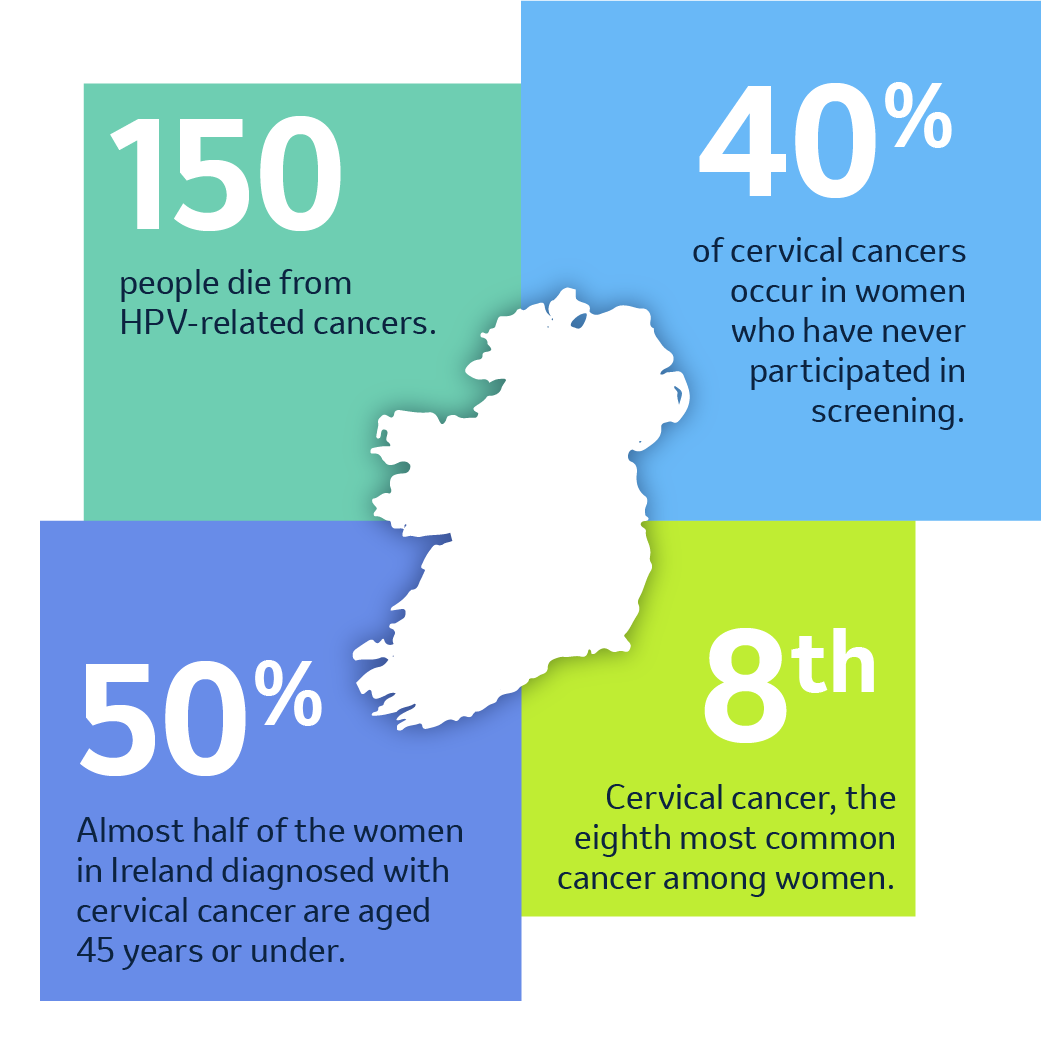About HPV
What is Human Papillomavirus (HPV)?
Human Papillomavirus (HPV) consists of over 100 related viruses which are responsible for nearly 5% of all cancers globally, including 99% of cervical cancer cases, making vaccination and education by primary care healthcare providers more crucial than ever.1,2,3
While most infections are asymptomatic and resolve on their own, some can lead to serious health issues in both men and women, including certain HPV-related cancers such as cervical, vaginal, vulvar and anal, and diseases such as genital warts.1
Each year in Ireland, approximately 150 people die from HPV-related cancers. Cervical cancer, the eighth most common cancer among women, sees around 260 new cases of invasive cervical and nearly 90 deaths annually.4,5.6
- HPV infections affect both men and women; however, while women have access to screening tests, there are currently no HPV screening options available for men.1,7
- HPV types 16 and 18 are responsible for 71% of cervical cancers globally.5
- There are more than 1,000 reported cases of genital warts in Ireland each year.6
- Almost half of the women in Ireland diagnosed with cervical cancer are aged 45 years or under.6
- 40% of cervical cancers occur in women who have never participated in screening.6
- There were 660,000 new cervical cancer cases annually worldwide in 2022, which resulted in 350,000 deaths (WHO).9

Increasing awareness, promoting vaccination to eligible patients, and encouraging uptake of the Cervical screening programs are essential steps in reducing the impact of HPV-related diseases.10 By taking these measures, we can work towards a future with fewer HPV-related health issues.
The Importance of HPV Vaccination
It is expected that HPV vaccination will reduce the incidence of HPV-associated cancers in the long term.11
- A study from Scotland found no cervical cancer cases in fully vaccinated women who received HPV immunisation at ages 12-13 since 2008.12
- Research published in October 2023 indicates that the introduction of the HPV vaccination program in Ireland has led to a significant 60% relative reduction in high-grade cytology rates among the vaccinated cohort of women who were screened between 2019 and 2022.13
A Healthier Future: Ireland’s Strategic Plan to Eradicate Cervical Cancer
Ireland has launched an ambitious Cervical Cancer Elimination Action Plan, aiming to eliminate cervical cancer by 2040. This plan focuses on increasing HPV vaccination rates to 90% for girls by age 15, maintaining cervical screening coverage above 70%, and ensuring over 90% of women receive necessary treatment. By enhancing vaccination, screening, and treatment, Ireland is taking significant steps toward a future where no woman faces the distress of a cervical cancer diagnosis.14
It’s not too late to vaccinate your adult patients against HPV
While HPV vaccination is part of Ireland’s national immunisation programme given to boys and girls in first year of secondary school, there may be unvaccinated adult cohorts who remain at risk of HPV. Most adults may not have been exposed to all HPV types covered by GARDASIL 9 and would be protected against HPV-vaccine types they have not been exposed to yet. Primary care providers are ideally placed to discuss the advantages of HPV vaccination with their adult patients, regardless of the patients age.15-18
People already infected with HPV can benefit from vaccination. There is no benefit to existing infections, but vaccination can prevent subsequent disease from future re-infection with the same type and can prevent new infections from other genotypes. 16

Primary Care Healthcare Professionals: Key Players in the Fight Against HPV
Your Role Matters
Your role is of critical importance in improving HPV vaccination uptake.19
As primary care HCPs, you are a vital cog in HPV education, prevention, and treatment:
- Educate patients about HPV, its transmission, and treatment.
- Administer vaccination to eligible patients, remembering it’s not too late to vaccinate. The HPV vaccination is licensed from age 9 with no upper age limit.
- Encourage uptake of cervical screening for cervical cancer and advise on follow-up care.
- Support patients by addressing their concerns about HPV.
Community Impact and Public Health Benefits
HPV vaccination can significantly decrease cervical cancer and other HPV-related diseases. As the HPV vaccine is a cancer-preventing vaccination, it will have a positive impact on reducing the burden of future HPV-cancers in the community.13
By talking to your patients about HPV and encouraging HPV vaccination, we can empower individuals to take proactive steps in preventing HPV-related diseases, ultimately fostering a healthier and safer community for all.
- Get Involved: Talk to your patients today about HPV and the importance of vaccination. You can find resources to help in our HCP section.
- Vaccinate: Ensure eligible patients receive vaccination.
- Cervical Screening: Prompt your patients for their cervical cancer screenings.
- HSE. About HPV – https://www.hse.ie/eng/health/immunisation/pubinfo/schoolprog/hpv/hpv-human-papillomavirus/ (Accessed July 2025)
- De Martel et al., 2017. Worldwide burden of cancer attributed to HPV by site, country and HPV type. IJC. 141. 664-670
- Wang K. Human papillomavirus and vaccination in cervical cancer. Taiwan J Obstet Gynecol. 2007;46(4):352-362
- HPV Information Centre. Human Papillomavirus and Related Diseases Report – https://hpvcentre.net/statistics/reports/IRL.pdf?t=1682437410994 (Accessed July 2025)
- NIAC. Chapter 10 – Human Papillomavirus – https://www.hiqa.ie/reports-and-publications/niac-immunisation-guideline/chapter-10-human-papillomavirus (Accessed July 2025)
- HSE. CervicalCheck Colposcopy Services September 2017 – March 2020: A comparative analysis – https://www.cervicalcheck.ie/_fileupload/CervicalCheck%20Colposcopy%20Services%20Sept%202017%20-%20March%202020%20-%20a%20comparative%20analysis%20.pdf (Accessed July 2025)
- HSE. Who should have cervical screening – https://www2.hse.ie/conditions/cervical-screening/who-should-have-cervical-screening/who-should-have-screening/ (Accessed July 2025)
- HSE. Annual Epidemiological Report, September 2019 – https://www.hpsc.ie/a-z/sexuallytransmittedinfections/publications/stireports/2018reports/Ano-genital%20warts%20in%20Ireland%202018%20(includes%20latest%20trends).pdf (Accessed July 2025)
- WHO. Cervical cancer – https://www.who.int/news-room/fact-sheets/detail/cervical-cancer (Accessed July 2025)
- HSE. Benefits and limitations of cervical screening – https://www2.hse.ie/conditions/cervical-screening/why-go/benefits-limitations/ (Accessed July 2025)
- National Cancer Registry Ireland. HPV-Associated Cancers – https://www.ncri.ie/en/reports-publications/reports/cancer-trends-40-hpv-associated-cancers#:~:text=The%20latest%20trends%20report%20on%20HPV-associated%20cancers%20estimates,of%20which%20are%20potentially%20preventable%20by%20HPV%20vaccination. (Accessed July 2025)
- Public Health Scotland. No cervical cancer cases detected in vaccinated women following HPV immunisation – https://publichealthscotland.scot/news/2024/january/no-cervical-cancer-cases-detected-in-vaccinated-women-following-hpv-immunisation/ (Accessed July 2025)
- Rourke, M. et al, (2024). Irish Journal of Medical Science, 193, 665–668. The effect of HPV vaccination on the rate of high-grade cytology in 25-year-old women attending cervical screening in Ireland.
- HSE. Ireland’s Cervical Cancer Elimination Plan – https://assets.hse.ie/media/documents/Irelands_Cervical_Cancer_Elimination_Action_Plan_2025-2030.pdf (Accessed July 2025)
- HSE. HPV Vaccination Programme in schools – https://www.hse.ie/eng/health/immunisation/pubinfo/schoolprog/hpv/hpv-vaccination-programme/ (Accessed July 2025)
- Meites E, Szilagyi PG, Chesson HW, Unger ER, Romero JR, Markowitz LE. Human Papillomavirus Vaccination for Adults: Updated Recommendations of the Advisory Committee on Immunization Practices. MMWR Morb Mortal Wkly Rep. 2019;68(32):698-702. Published 2019 Aug 16. doi:10.15585/mmwr.mm6832a3.
- Tota JE, Giuliano AR, Goldstone SE, et al. Anogenital Human Papillomavirus (HPV) Infection, Seroprevalence, and Risk Factors for HPV Seropositivity Among Sexually Active Men Enrolled in a Global HPV Vaccine Trial. Clin Infect Dis. 2022;74(7):1247-1256. 35.
- Ferris DG, Brown DR, Giuliano AR, et al. Prevalence, incidence, and natural history of HPV infection in adult women ages 24 to 45 participating in a vaccine trial. Papillomavirus Res. 2020;10:100202.
- Sackley, E., M. et al. Healthcare professional’s promotional strategies in improving Human papillomavirus (HPV) vaccination uptake in adolescents: A systematic review. Vaccine. 2022 Apr 26;40(19):2656-2666.
IE-GSL-00209 | Date of preparation: October 2025
